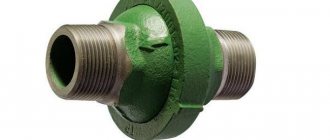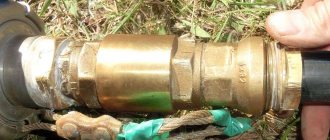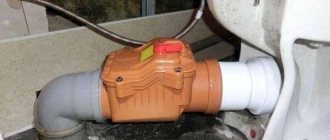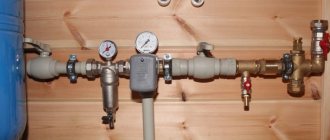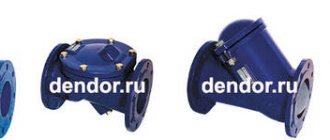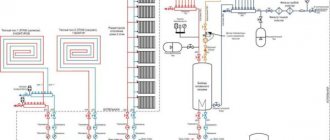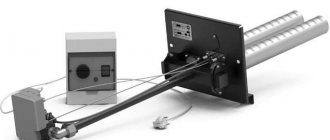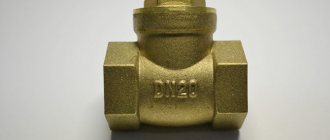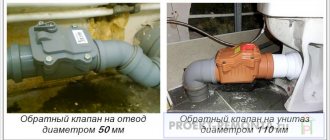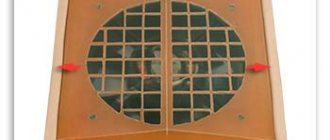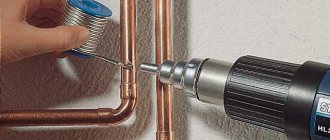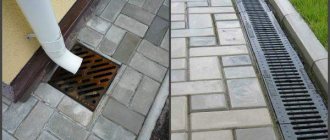Types of check valves
Basically, check valves are grouped according to several characteristics: material of manufacture and type of locking device.
The most popular valves are those made of brass, cast iron, and steel. Based on what kind of locking device is installed, the following types are distinguished:
- disc-shaped;
- ball;
- petal;
- gravitational;
- bivalve.
Disc-shaped.
The basis of its design is a disc in the shape of a plate; it is responsible for closing the section in the circuit if conditions in the system change. Such a disk is placed in a special seat with a flexible seal, and its inner part is connected to the rod.
Wafer spring disc check valve
Ball.
This type of valve is almost identical to the previous type. The main difference is that the main element of the mechanism is not a plate, but a ball. It can be made of aluminum or rubber and at the moment when the spring is triggered (if the direction of water flow changes), the ball is directed into the seat and closes the section. Thus, the coolant cannot move back. Such valves are designed for a standard heating system.
Despite the importance of a check valve, if the circuit involves pipelines with a sufficiently large diameter, then a device of neither a ball nor a disc type will provide maximum protection.
Ball Type Check Valve
Double-leaf.
This variety was created specifically for large-diameter pipelines. It can be installed on the return circuit and on the water supply circuit in the heating system. In this case, the principle of operation of the device will remain unchanged.
The valve, which includes two flaps, will, under normal operating environmental conditions, begin to operate under the pressure exerted by the coolant.
If an emergency occurs, the device will be closed with flaps that will not restrict the movement of water in the wrong direction. At the flow section of a two-leaf valve there is a special axis on which the flaps are fixed. This type of shut-off valve is recognized as one of the most reliable, making it suitable for use in systems with high pressure.
Wafer check valve Tecofi CB 3449 cast iron double-leaf
Petal.
A reed check valve is also called a gravity check valve. Its design includes a spring with low elasticity, which is responsible for its low resistance. In certain modifications there is no spring, and during operation a phenomenon is used that is caused by gravity and flow pressure. This valve is equipped with a spring-loaded flap with a seal, which is fixed at the top point of the cross-section on the axis.
Reed type check valve
Check valves for heating: petal, disk, lift, ball
One of the most important conditions for the correct operation of a heating and any other pipeline system through which liquid or gaseous working media are transported is the movement of such media in one direction. A technical device that allows this important requirement to be met is a reed valve or any other type. Check valves in pipeline systems through which gaseous and liquid media are transported, they ensure the movement of such media in one direction and block them if the direction of their movement changes. Clutch-type check valves
Types of check valve devices
The modern market offers check valves of various types, each of which differs in both its design and technical characteristics. Disc-type check valves The design of such devices includes a body, which can be made of brass or stainless steel, and a locking mechanism. The latter consists of the following elements:
- a metal or plastic disc valve, which ensures that the flow of the transported medium is blocked if it begins to move in the wrong direction;
- a sealing gasket that serves for a tighter fit of the butterfly valve to the seat;
- steel spring, which ensures that the valve is in the closed state if the flow of the working medium moves in the wrong direction.
Operating principle of a disc check valveSpring disc check valves, which are ideal for equipping domestic heating systems and do not require regular maintenance, have the following advantages:
- compact size and light weight;
- affordable price.
However, spring disc valves also have disadvantages:
- When using check valves of this type in heating systems, significant hydraulic resistance is created, which is especially critical when such systems use a geothermal heat pump. That is why in such cases it is necessary to perform preliminary calculations.
- Spring disc type check valves, which are a maintenance-free type, cannot be repaired.
Poppet type check valve with brass disc Ball check valves Unlike a disc valve, a ball valve has better hydraulic characteristics, which is the reason for its high popularity among consumers. The locking element of this device, as is clear from its name, is a rubber-coated ball that can be made of cast iron or aluminum. The principle by which a check-type ball valve works is quite simple.
- When the coolant moves through the ball valve in the required direction, the shut-off element - the ball - under the pressure of the working medium rises to the upper part of the device, completely opening the passage hole.
- In the event that the pressure of the working fluid flow decreases or it begins to move in the wrong direction, the ball, under the influence of its own weight, drops into a special niche, closing the passage hole and blocking the movement of the working fluid flow through the device.
Ball-type heating check valve A ball check valve is usually equipped with a cover that is attached to its body using several bolts. The presence of such a cover allows you to quickly and easily carry out repairs and maintenance of the valve, if the need arises. When installing check ball valves on pipelines for various purposes, the following nuances must be taken into account.
- The ball valve should be positioned with the lid facing upward when installed on a horizontal section of the pipeline, so that the ball located in the working compartment of the device can freely roll into its lower part.
- When installing a check ball valve on a vertical section of the pipeline, it is necessary to take into account that the flow of the working medium passing through the device must move in the direction from bottom to top.
The operation of this valve is ensured by a ball moving inside the housing under the influence of the coolant. Leaf-type check valves A petal check valve, the shut-off elements of which are two spring-loaded flaps (petals) located on a special axis, is installed on the pipeline systems of large boiler stations and heating points. One of the most significant disadvantages check valves belonging to the petal type have weak hydraulics. This is explained by the fact that their valves, even when in the open state, create a significant obstacle to the flow of the working medium moving through the pipeline. Petal valve devices include a gravity check valve, the shut-off element of which is one leaf mounted on a special axis and able to rotate freely. The gravity check valve operates according to the following principle.
- Under the pressure of the flow of the working medium, the valve opens.
- If the pressure of the working fluid flow drops or it begins to move in the wrong direction, the flap lowers under the influence of its own gravity, closing the device.
There is no spring in a horizontal petal valve for heating, which makes it possible for the valve to operate even when water moves by gravity. Lift-type check valves. The closing element of such devices is a spring-loaded spool moving on a special axis. Some models are not equipped with a spring; they can only be used for installation on vertical sections of pipelines .Like ball check valves, rotary check valves are equipped with a cover allowing them to be repaired and maintained if necessary.
When installing, lift-type spring check valves must be installed with the cover facing upward, which will provide access to their interior in cases where it is necessary to carry out their repair or maintenance.
Lift type check valve device
Installation methods
Check valves also differ according to the type of installation in heating systems and in other piping systems. So, depending on this parameter, several types of devices are distinguished.
- Flange-type devices are installed mainly on pipelines with a large diameter. Distinctive features of flange-type valves are two flanges welded to their body. On pipelines, flange-type check valves are installed using bolted connections.
- Wafer check valves are the most compact among all devices of this type. To install such check valves, flanges are also used, but they are fixed to the elements of the pipeline system. The valve itself is installed in special seats between two flanges, which are tightened together using threaded rods.
- As a rule, coupling-type check valves are installed on domestic pipeline systems. Their installation consists of simply screwing them onto the pipeline elements.
- There are check valves installed by welding. They are usually placed in systems equipped with pipes made of polymer materials.
Check valve in the heating system
How to perform installation correctly
When installing a check valve for heating, you need to follow simple recommendations.
- Focusing on the arrow on the body of the check valve, it is necessary to install it on the pipeline so that the direction of the arrow coincides with the direction in which the flow of the working medium will move in the pipeline.
- Do not use gaskets that will reduce the cross-sectional size of the bore.
- The elements of the pipeline system on which the check valve is installed must not exert pressure on its body.
- On the part of the pipeline through which the transported medium will flow into the check valve, it is necessary to install a strainer. Such a filter will prevent solid particles from entering the locking mechanism. It should be borne in mind that clogging of the internal part of the check valve can lead to a violation of the tightness of the device when closed.
Types of check valves
According to their internal structure and purpose, water check valves are divided into the following types:
The valve is wafer, spring disc and double leaf.
The most compact design among all types.
In a spring disc valve, the shutter is a disk (plate) with a pressing element - a spring.
In working condition, the disc is pressed out under water pressure, ensuring free flow.
When the pressure decreases, the spring presses the disk against the seat, blocking the flow hole.
Check valve size range 15 mm – 200 mm.
In complex hydraulic systems, when the pump stops, a water hammer may occur, which can cause damage to the system.
In such systems, double-leaf valves are used: in large and complex systems, with shock absorbers to mitigate water hammer.
In them, the locking disc is folded in half under the influence of water flow. The reverse flow returns the disc to its original state, pressing it against the seat. Size range 50 mm – 700 mm, even larger than spring disc valves.
The main advantages of wafer check valves are their smaller size and light weight. Their design does not have flanges for fastening to the pipeline.
Due to this, the weight is reduced by 5 times, and the total length by 6-8 times compared to standard check valves of the same bore diameter.
Advantages: ease of installation and operation, the ability to install in addition to horizontal sections of the pipeline, also on inclined and vertical ones.
Disadvantage: complete dismantling is required when repairing the valve.
Rotary or reed check valve
In this design, the locking element is a spool - a “flap”.
The axis of rotation of the “flap” is located above the passage hole. Under the influence of pressure, the “flap” reclines and does not interfere with the passage of water.
When the pressure drops below the permissible value, the spool falls and slams the passage channel.
In large-diameter check valves, the spool strongly impacts the seat, which leads to rapid failure of the structure.
During further operation, this provokes the occurrence of a water hammer when the check valve is activated.
Therefore, rotary check valves are divided into two groups:
- Simple – valves with a diameter of up to 400 mm. They are used in systems where shock phenomena cannot seriously affect the operation of the hydraulic system and the valve itself.
- Impactless - valves with devices that ensure a smooth and soft landing of the spool on the seat.
The advantage of rotary valves is their ability to operate in large systems and low sensitivity to environmental contamination.
A similar valve is installed in NASA's wind tunnel, which is 7 meters in diameter.
The disadvantage is the need to use a damper in large diameter valves.
Reverse ball
The operating principle of a check ball valve is similar to that of a wafer spring disc valve.
The locking element in it is a ball with a spring that presses it to the seat. Ball check valves are used in systems with small diameter pipes, most often in plumbing.
The ball check valve is inferior to the spring disc valve in terms of dimensions.
Reverse lift
In a lift check valve, the shut-off element is a lift spool.
Under the influence of water pressure, the spool rises, allowing flow to pass through.
When the pressure drops, the spool moves down onto the seat, preventing the flow from flowing back.
Such valves are installed only on horizontal sections of pipelines. A prerequisite is the vertical location of the valve axis.
The advantage of a check lift valve is that it can be repaired without dismantling the entire valve.
Disadvantage: high sensitivity to environmental pollution.
Valves are divided into four groups according to the method of fastening.
- Welding fastening. The check valve is attached to the pipeline by welding. Used when working in aggressive environments.
- Flange mounting. The check valve is connected to the pipeline through sealed flanges.
- Coupling fastening. The check valve is attached to the pipeline through a threaded coupling. Used in small diameter systems.
- Wafer mount. The check valve does not have its own mounting unit. Clamped between pipeline flanges. Used in areas with limited dimensions.
Advantages and disadvantages
A check valve with a filter helps prevent the plate from jamming in any position.
The check valve has advantages and disadvantages that are common to all types of devices. There will be no hot flow into the riser if cold liquid flows there. This extends the performance of system elements that are designed for a certain temperature. The devices are easy to install and do not create noise during the passage of liquid. Check valves solve the problem only in a specific area; additional control devices are installed for other circuits.
Some mechanisms allow the occurrence of water hammer when the flow passes through the working unit, but this feature of the valve only harms a system with a large diameter. The valves become dirty from the water flow if the system operates with an energy carrier without propylene glycol or other additives. In this case, the disc or plate may become stuck in the open or closed position.
Materials, markings, sizes
The check valve for water is made of stainless steel, brass, larger sizes are made of cast iron. For household networks, brass is usually used - it is not too expensive and durable. Stainless steel is, of course, better, but it is usually not the body that fails, but the locking element. This is where you should approach your choice carefully.
For plastic plumbing systems, check valves are made from the same material. They come in polypropylene and plastic (for HDPE and LDPE). The latter can be welded/glued or threaded. You can, of course, solder adapters to brass, install a brass valve, then again an adapter from brass to PPR or plastic. But such a unit is more expensive. And the more connection points, the lower the reliability of the system.
For plastic and polypropylene systems there are check valves made of the same material
The material of the locking element is brass, stainless steel or plastic. Here, by the way, it’s hard to say which is better. Steel and brass are more durable, but if a grain of sand gets between the edge of the disk and the body, the valve jams and it is not always possible to return it to functionality. Plastic wears out faster, but it doesn’t jam. In this regard, it is more reliable. It’s not for nothing that some manufacturers of pumping stations install check valves with plastic discs. And as a rule, everything works for 5-8 years without failures. Then the check valve begins to “poison” and is replaced.
What is indicated in the labeling
A few words about the marking of the check valve. It states:
- Type
- Conditional pass
- Conditional pressure
- GOST according to which it is manufactured. For Russia, this is GOST 27477-87, but there are not only domestic products on the market.
The conditional diameter is designated as DU or DN. When choosing this parameter, you need to focus on other fittings or pipeline diameter. They must match. For example, you will install a check water valve after a submersible pump, and a filter next to it. All three components must have the same nominal diameter. For example, all should have DN 32 or DN 32 written on them.
A few words about conditional pressure. This is the pressure in the system at which the shut-off valves remain operational. You should definitely take it no less than your working pressure. In the case of apartments - no less testing. According to the standard, it exceeds the working one by 50%, and in real conditions it can be much higher. You can find out the pressure for your home from the management company or plumbers.
What else to pay attention to
Each product must come with a passport or description. It indicates the temperature of the working environment. Not all valves can work with hot water or in a heating system. In addition, it is indicated in what position they can work. Some should only stand horizontally, others only vertically. There are also universal ones, for example, disk ones. That's why they are popular.
Opening pressure characterizes the “sensitivity” of the valve. For private networks it rarely matters. Only on supply lines close to the critical length.
Also pay attention to the connecting thread - it can be internal or external. Choose based on ease of installation
Don't forget about the arrow that indicates the direction of water movement.
Dimensions of check valves for water
The size of a check valve for water is calculated according to the nominal diameter and they are produced for all - even the smallest or largest pipeline diameters. The smallest is DN 10 (10 mm nominal bore), the largest is DN 400. They are the same sizes as all other shut-off valves: taps, valves, drains, etc. Conditional pressure can also be referred to as “dimensions”. The lowest is 0.25 MPa, the highest is 250 MPa.
Each company produces check valves for water in several sizes.
This does not mean that any of the valves will be in any variant. The most popular sizes are up to DN 40. Next come the main ones, and they are usually purchased by enterprises. You won't find them in retail stores.
And also, please note that for different companies, with the same nominal diameter, the external dimensions of the device may differ. The length is clear
Here the chamber in which the locking plate is located may be larger or smaller. The diameters of the chambers also differ. But the difference in the area of the connecting thread can only be due to the thickness of the walls. For private houses this is not so scary. Here the maximum working pressure is 4-6 Atm. But for high-rise buildings it can be critical.
How to check
The easiest way to test a check valve is to blow into it in the direction that is blocking it. No air should pass through. At all. No way. Also try pressing on the plate. The rod should move smoothly. No clicks, friction, distortions.
How to test a check valve: blow into it and check for smoothness
Types of devices and areas of their application
The selection of the device is dictated by the conditions in which it will be used; it depends on the type of heating networks and their internal pressure. An incorrectly selected mechanism can itself cause emergency situations. For example, the liner part that is proposed to be placed inside the cold water meter can completely block its current if the pressure is insufficient, or significantly limit it. On the other hand, installed at the water supply inlet, it will prevent coolant leakage, maintaining pressure, pressure and amount of water in the system.
Gravity check valve for heating
It is also called a firecracker valve and is used only in gravity systems, usually installed at the inlet to the boiler. It consists of a metal “petal”, which is pressed tightly against the edge using a spring.
The spring in the gravity check valve is quite weak and does not interfere with the natural circulation of the coolant.
The spring in such a device is quite weak and does not interfere with the natural circulation of the coolant, like the next presented option.
Ball valve for heating
It is used less often, since there is a danger that the ball, which moves inside the mechanism, opening and closing the flow of water, may jam in one position and then the device will not perform its job properly.
This feature has led to the fact that today the ball check valve is practically not used in heating networks of private houses.
Disc-shaped
This product is used in networks that operate with a pump, as well as those with several active heating circuits. This is due to the fact that the spring located inside the device has greater rigidity, and therefore resistance.
Inside there is a metal or plastic disk (metal is always used for heating), combined with a sleeve on which a spring is attached. Thus, when the proper pressure occurs in the pipe, the plate rises and does not interfere with the flow of coolant. However, as soon as the pressure drops, the opening closes, preventing the outflow of water in the opposite direction.
Coupled
All the products discussed above were completely autonomous and were not subject to external influences, working only in one direction. But in cases where it is necessary, for example, to drain coolant from pipes, a device is needed that makes it possible to open the coolant flow in the opposite direction - such a device is a coupling or valve valve.
When it is necessary to drain coolant from pipes, you need a device that makes it possible to open the coolant flow in the opposite direction; for this, a coupling or valve valve is used.
The choice between a coupling and a valve is most often determined by the internal operating pressure of the network; if it is high, a valve is used; if it is average, a coupling will suffice.
Ball valve
A ball check valve for heating is a universal device.
Its design consists of the presence of a sphere, which, in fact, creates a locking mechanism. Namely, the coolant flow lifts the sphere and places it in the end pipe. The operating principle of the ball device is that if the pressure decreases or the circulation of the coolant stops altogether, the ball drops into the end pipe and blocks the passage
It is very important that the pipe that is adjacent to the ball valve must be of the same diameter
Ball valves are very reliable, since there are practically no malfunctions in them due to the absence of complex moving mechanisms. But it should be noted that the ball model is quite expensive due to difficulties in manufacturing. A ball device is installed on pipes whose cross-section is larger than 40 mm, that is, it is not suitable for the heating system of a private house. The minimum pressure must be 25 bar, otherwise the ball will not be able to rise. That is, the ball device is mounted only on large highways, as well as in autonomous systems in production (industrial, commercial).
Rice. 3 Flap valve
Features of three-way safety valves
We should also talk about a device that is not so well known to consumers - a three-way valve with a manual or electric switch. It is used in heating systems with low temperature circuits.
The fuse design is equipped with three holes, one of which is input, two are output. The flow of the medium is controlled by a damper made in the form of a ball or rod. The moving fluid is redistributed by rotations.
Three-way fuses are appropriate for condensing boilers and in cases where several different systems operate from one heating equipment
Let's imagine a situation: the house has a heating scheme with a system of conventional radiators and heated floors. The technical requirements for the operation of the second option provide for not too high coolant temperatures.
The boiler heats water at the same temperature for all systems. In such conditions, there is a need for a redistributing device, the tasks of which are perfectly handled by a three-way valve.
It is responsible for the following functions:
- delimitation of areas;
- distribution of flux density by zones;
- facilitating the mixing of coolant from the main supply/return branches to send colder water into the underfloor heating pipeline than into the radiators.
In order not to constantly control the temperature of the medium yourself, you need to pay attention to valve models equipped with a servo drive. This device operates from a sensor installed in the low temperature circuit
When the temperature changes, a locking mechanism is activated, opening or closing the liquid supply from the return line
This device operates from a sensor installed in the low-temperature circuit. When the temperature changes, a shut-off mechanism is activated, opening or closing the liquid supply from the return line.
We talked in more detail about the types of three-way valves for heating and the criteria for its selection in the next article.
Installation
- A gravity device is installed to prevent hot water from flowing into cold water.
- To eliminate vibration pressure that affects devices. For example, when exposed to it, the counter may spin. By installing a gravity check valve for heating, this pressure does not extend beyond the installation location of the device. This vibration pressure arises from water hammer, which can be created by old taps, etc.
- It is necessary to install such a device on a double-circuit boiler so that water is not pumped out of the heating system.
- Installed on a heated floor system. Install a gravity check valve for heating on the pipe, which is on the return line.
This element is also widely used in connecting various water heaters and water supply systems.
Rice. 2 Ball model
Options for working connection schemes
Heating systems are very diverse and the presence of a check valve is not necessary in all of them. Let's consider several cases when its installation is necessary. First of all, a check valve must be installed on each of the individual circuits in a closed circuit, provided that they are equipped with circulation pumps.
Some craftsmen strongly recommend installing a spring-type check valve in front of the inlet pipe of the only circulation pump in a single-circuit system. They motivate their advice by the fact that in this way pumping equipment can be protected from water hammer.
This is in no way true. Firstly, installing a check valve in a single-circuit system is hardly justified. Secondly, it is always installed after the circulation pump, otherwise using the device loses all meaning.
If two or more boilers are included in the heating circuit, the occurrence of parasitic flows is inevitable. Therefore, connecting a check valve is mandatory
For multi-circuit systems, the presence of a reverse-acting shut-off device is vital. For example, when two boilers are used for heating, electric and solid fuel, or any others.
When one of the circulation pumps is turned off, the pressure in the pipeline will inevitably change and a so-called parasitic flow will appear, which will move in a small circle, which can lead to trouble. It is impossible to do without shut-off valves here.
A similar situation arises when using an indirect heating boiler. Especially if the equipment has a separate pump, if there is no buffer tank, hydraulic arrow or distribution comb.
Here, too, there is a high probability of a parasitic flow, to cut off which a check valve is needed, which is used specifically for arranging a branch with a boiler.
It is mandatory to use shut-off valves in systems with bypass. Such schemes are usually used when converting a scheme from gravitational fluid circulation to forced circulation.
In this case, the valve is placed on the bypass parallel to the circulation pumping equipment. It is assumed that the main mode of operation will be forced. But if the pump is turned off due to lack of electricity or breakdown, the system will automatically switch to natural circulation.
When installing bypass units for heating circuits, the use of check valves is considered mandatory. The figure shows one of the possible bypass connection options
This will happen as follows: the pump stops supplying coolant, the check valve actuator unit ceases to experience pressure and closes.
Then the convection movement of the liquid along the main line resumes. This process will continue until the pump starts working. In addition, experts suggest installing a check valve on the make-up pipeline. This is not necessary, but highly desirable, since it allows you to avoid emptying the heating system for a variety of reasons.
For example, the owner opened a tap on the make-up pipeline to increase the pressure in the system. If, by an unpleasant coincidence, the water supply is cut off at this moment, the coolant will simply squeeze out the remaining cold water and go into the pipeline. As a result, the heating system will be left without liquid, the pressure in it will drop sharply and the boiler will stop.
In the circuits described above, it is important to use the correct valves. To cut off parasitic flows between adjacent circuits, it is advisable to install disk or petal devices
In this case, the hydraulic resistance will be lower in the latter option, which must be taken into account when choosing.
In heating systems with natural coolant circulation, the use of spring check valves is impractical. Only paddle rotators can be installed here
To install a bypass unit, it is preferable to choose a ball valve. This is due to the fact that it provides almost zero resistance. A disc-type valve can be installed on the make-up pipeline. This should be a model designed for fairly high operating pressure.
Therefore, a check valve may not be installed in all heating systems. It is necessarily used when installing bypasses of all types for boilers and radiators, as well as at pipeline branch points.
Where is it installed in the heating system?
The general purpose of a check valve is to allow coolant flow in one direction and prevent it from moving back. They do not require power or any other conditions to operate; they operate from the movement of liquids. A check valve for heating is installed in all positions where backflow and parasitic circuits may occur.
In a heating system with several branches, a check valve is placed on the return pipeline. This prevents the pump from “pushing” the flow in the opposite direction.
The same devices are installed in cold and hot water supply. Those intended for heating are distinguished by the fact that materials are used that can withstand prolonged exposure to elevated temperatures. If there are rubber gaskets, then heat-resistant rubber is used. The same applies to plastic parts.
If we talk specifically about heating systems (HC), then a check valve is installed:
- To a bypass with a circulation pump in the piping of a solid fuel boiler - to ensure operation of the system in gravity mode (with natural circulation). In this case, models with the least resistance are installed, which operate easily and quickly - immediately when a flow from natural circulation appears. The function of the valve, in this case, is not to bypass the coolant when the pump is running.
- On the return pipeline when installing an indirect heating boiler. Why install a check valve in this case? To prevent the flow of coolant in the opposite direction when the circulation pump is operating.
- With a branched heating system (for example, on several floors), on each branch. These check valves prevent the coolant from being “pulled” if one of the branches is turned off (when using one circulation pump).
- On the system's cold water make-up line. Here, in addition to the shut-off valve, a return valve is also needed. Since sometimes the pressure in the water supply is lower than in the heating system. Then, when opening the tap to refuel the system, without a check valve, the coolant will “go” into the water supply system.
Symbol of a check valve in the diagram
In the diagrams, the check valve is designated as two triangles with their vertices directed towards each other. One of the triangles is shaded. The installation location in the branch is almost any. The main thing is that it exists. The direction of flow is indicated by an arrow on the housing. The coolant flows in this direction. In the opposite case, it overlaps. When installing, carefully follow the arrow (you can also focus on the locking element).
Rotary check valve
There are models with flange or coupling connections. The body and removable cover of the rotary valve are made of cast iron, bronze or stainless steel. The locking element is a stainless steel disk, which rises upward under the pressure of the direct flow of coolant.
Cast iron swing check valve Zetkama V302. Max. temperature up to +300°C.
Thanks to the full opening of the bore, the rotary valve has high hydraulic performance.
Like ball check valves, rotary valves are also mounted in a horizontal position with the lid up, and in a vertical position so that the coolant flow moves from bottom to top.
Reed valve
The design feature of the petal device is the presence of a steel plate. This type of check valve can be single-leaf or double-leaf.
With a double-leaf device, the axis is installed in the middle of the highway, and on the sides there are plates that serve as flaps. The fastenings are located on the inner platform. With the petal device installed, there will be minimal hydropathic losses. They are manufactured with interflange mounting.
Single leaf petal models are made of cast iron and are installed with minimal clearances.
Types of locking elements
Any check valve (the outdated name is non-return) performs a simple task - it does not allow the coolant flow to change direction, passing liquid only in one direction. In water heating schemes, this function is not always needed and is implemented as needed.
The following types of check valves are used in heating systems of private houses and apartments:
- petal;
- disc-shaped;
- ball
Industrial models are installed in large boiler houses and production facilities
Let us analyze the device and operating principle of each type of valve separately. In the future, this will help you understand which product is best to select and install in a specific heating system.
Reed valves
The element, made of brass or stainless steel, consists of the following parts:
- body in the form of a tee with a unscrewing top plug (for maintenance);
- a butterfly valve mounted on an axis by means of a rotary lever;
- a seat with a seal into which the disc fits when closed.
The general design of a reed check valve is shown in the detailed drawing. The principle of operation of the element is as follows: the coolant moving in the indicated direction deflects the locking disc and freely passes further along the pipe. When the direction of water flow is reversed, the valve, under the influence of gravity (or a spring), automatically slams shut and blocks the passage.
Typical gravity seal design
We list the important characteristics of petal check valves installed in heating systems of private houses:
- internal passage diameter – from 15 to 50 mm (½—2 inches);
- maximum working pressure – 16 Bar;
- low hydraulic resistance;
- There is a screw on the side of the body for disassembling and adjusting the shutter axis;
- The gravity version without spring can only work normally in a horizontal position.
The design and operating principle of the rotary valve is shown in detail in the video:
Poppet valves
The principle of operation of a poppet check valve is clear from its design, shown in the drawing:
- Inside the cylindrical brass body there is a platform with a round hole - a saddle.
- On the other side of the part there is a partition with a hole in the center.
- A rod with a disc-type valve at the end equipped with a seal is inserted into the hole in the partition.
- A spring is installed between the partition and the “plate”, pressing the disk to the seat.
Water flowing in the right direction overcomes the elastic force of the spring, opens the valve and moves on. Flow in the opposite direction is impossible - the duct instantly closes. What properties of a check valve are important for heating systems:
- ability to function in any orientation of the body in space;
- working pressure – not less than 10 Bar, diameters DN15 – DN100 (internal);
- type of connection – coupling (internal pipe thread);
- spring lock creates increased hydraulic resistance to fluid flow;
- The seal loses its tightness if solid particles, such as sand, enter.
In the utility networks of private houses and apartments, valves with coupling connections are used.
Disc valves are also used in water supply networks, for example, in conjunction with submersible pumps. The valve prevents water from the pipelines from flowing back into the well or borehole.
Ball valves
This is a check valve of the simplest design, operating on the following principle:
- Inside the cylindrical brass body there is a ball made of rubber, less often aluminum.
- The ball is prevented from jumping out by 2 partitions with holes made along the edges.
- The coolant flow presses the rubber ball against the partition with ribs. These protrusions form a gap where water flows freely.
- If the coolant moves in the opposite direction, the ball will press against the second jumper - the seat. Since there are no ribs, the body of the ball will completely cover the passage hole.
The advantages of a ball check valve are low price, low hydraulic resistance and operation without any springs in any position, although vertical is preferable. The disadvantage is the loss of tightness when the pressure increases to 6-7 bar, which does not happen in individual heating networks.
To take a closer look at the ball valve, watch the following video:
Date: September 25, 2021
Installing the valve correctly
To avoid making mistakes when choosing and installing a check valve in the right place in the heating system, listen to these simple recommendations:
- To avoid stray flows in adjacent branches, install petal or disc type products. The former are preferable because they do not create increased hydraulic resistance.
- In the bypass assembly of a gravity system, use a ball valve that has virtually zero resistance.
- For refilling, choose an element with a poppet valve designed for high pressure.
Products with gravity butterfly valves are always placed horizontally with the plug facing up - The gravity type reed valve is always mounted horizontally. Moreover, the head of the service nut must be vertical, otherwise the valve will not close and will begin to leak coolant in the opposite direction.
- Do not purchase fittings with a cast iron body. It is heavier and less reliable in operation.
- Check the correct installation by the arrow on the valve body indicating the direction of water flow.
- You cannot install fittings with a spring lock in a circuit with natural circulation - gravity flow will stop due to high resistance.
Disc and leaf valves require periodic maintenance and cleaning. If solids or deposits become trapped under the seat seal, the non-return valve will lose its seal. The best cleaning method is to remove the element and blow off the adjacent surfaces with a compressor.
